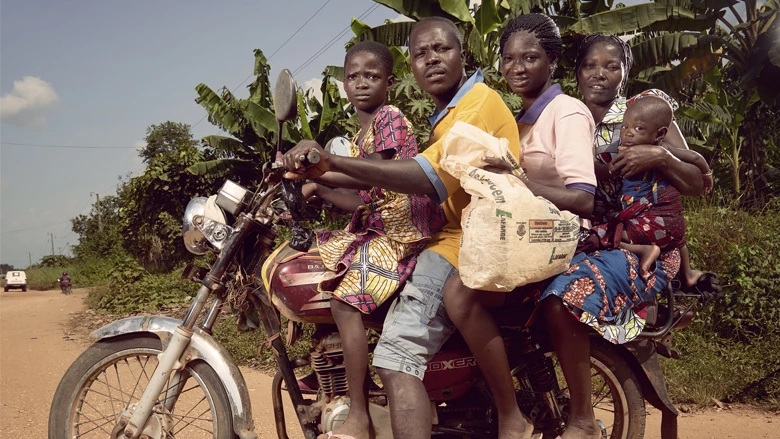 Family on a motorcycle
Family on a motorcycle
In the two decades between 1995 and 2015, global growth had a profound impact on the social structure of many developing countries and helped create a middle class worldwide. According to the African Development Bank, in Sub-Saharan Africa the middle class accounted for 14 percent of the total population by 2011, about 127 million people.
In general, people in the middle class have formal employment, and their income sources tend to be less affected by seasonality than those of the poor. They are more likely to hold most of their savings in financial assets, money deposited in bank accounts or housing. Likewise, the new emerging middle class in developing countries exhibits consumption patterns akin to more established groups in richer countries; that is, they diversify their expenditures away from basic needs toward more durable goods (home appliances, computers, smart-phones, cars), luxury goods, entertainment (restaurants, movies, travels), and in some cases real estate.
All these elements, when taken together, suggest that for countries in Sub-Saharan Africa where welfare is measured in terms of consumption only, rather than income, it is very likely that a substantial piece of information regarding the welfare of the top 10 to 20 percent of the population is overlooked. Consumption has important advantages when looking at lower-income percentiles; however, it is now widely recognized that it underestimates the actual welfare of the richer part of the population since it does not account for savings (as well as transfers) and does not factor in many non-basic expenditures. Intuitively, this underestimation affects the calculation of various inequality measures, yielding much lower results.
Our recent paper tries to overcome these problems by testing and applying a new methodology for reconstructing a more realistic welfare distribution in Sub-Saharan Africa, and then measuring inequality more accurately. In a nutshell, the idea is to correct the consumption distribution around the top quintile using information coming from the income distribution in the same survey. This is available for a certain number of countries using the Rural Income Generating Activities database, a collaborative effort of the Food and Agriculture Organization of the United Nations, the World Bank, and American University. Results show that in Ghana, Kenya, Malawi, Niger, Nigeria and Uganda, inequality increases substantially. Depending on the threshold used, Gini, the indicator used to measure inequality, on average increases by 20 percent compared to the original figures. In terms of levels, it is important to note that in four of the six countries analyzed, inequality levels reach those of the traditionally unequal countries of the southern cone (South Africa and neighbors).
Further research is clearly needed, such as having data points for a single country to gauge all trends. Nonetheless, we can draw some preliminary conclusions, based on this outcome.
First, these new inequality figures seem more in line both with findings from development theory and with what the present structure of these economies would suggest. Literature has pointed at the existence of large productivity gaps between agriculture and non-agricultural sectors that occur when economic growth takes off. In Sub-Saharan Africa, where the agricultural sector still employs around 50 percent (or more) of the labor force and where the production’s aim is mainly subsistence, this gap is expected to translate into significant income gaps. The gap also has an important spatial dimension, since many African economies appear to be highly dualistic, with long-standing spatial differences in terms of human capital, infrastructures, and economic opportunities.
Second, policy-wise, our results indicate that inequality should be treated as a central problem of concern in African economic policy debates, much as it has been in Latin America and in South Africa. Therefore, SSA countries need to start now to develop a strategy that, if not able to immediately reverse high inequality, at least can mitigate its impact.
The current coronavirus outbreak will have far-reaching policy implications across the region that could be amplified by inequality. The stress the pandemic places on basic public services, especially in health care and education provision, will become apparent downstream. For instance, due to hampered value chains, gaps in access to critical medicine (e.g., against malaria) or pesticides for agricultural productivity (against locust outbreaks) will have repercussions on the poorest more than the richest.


Join the Conversation